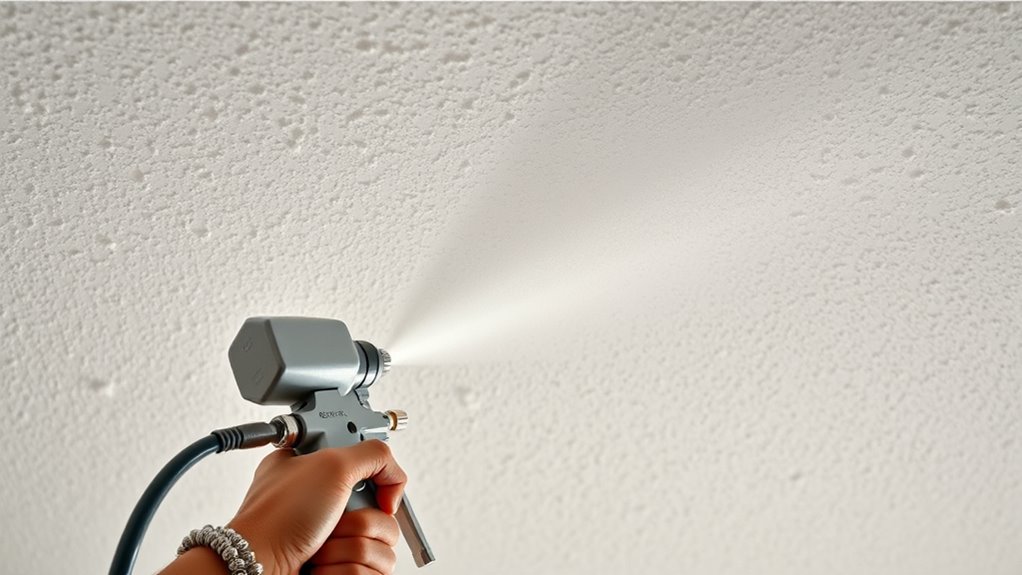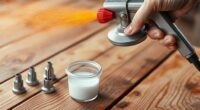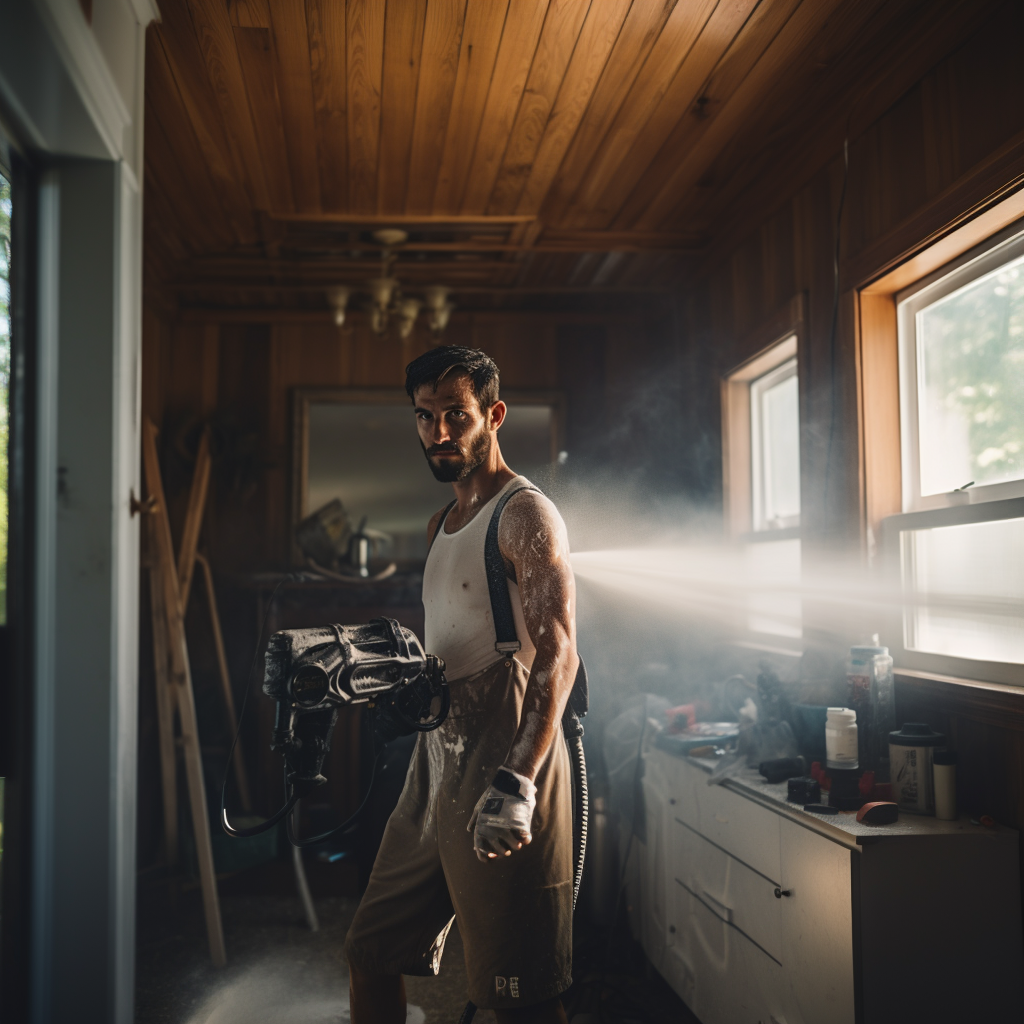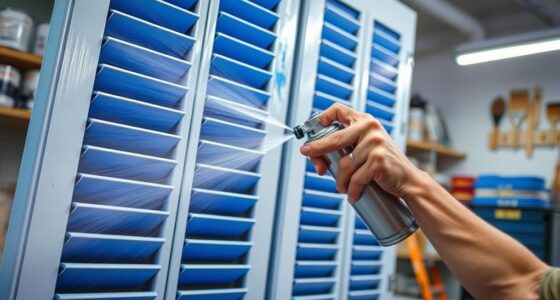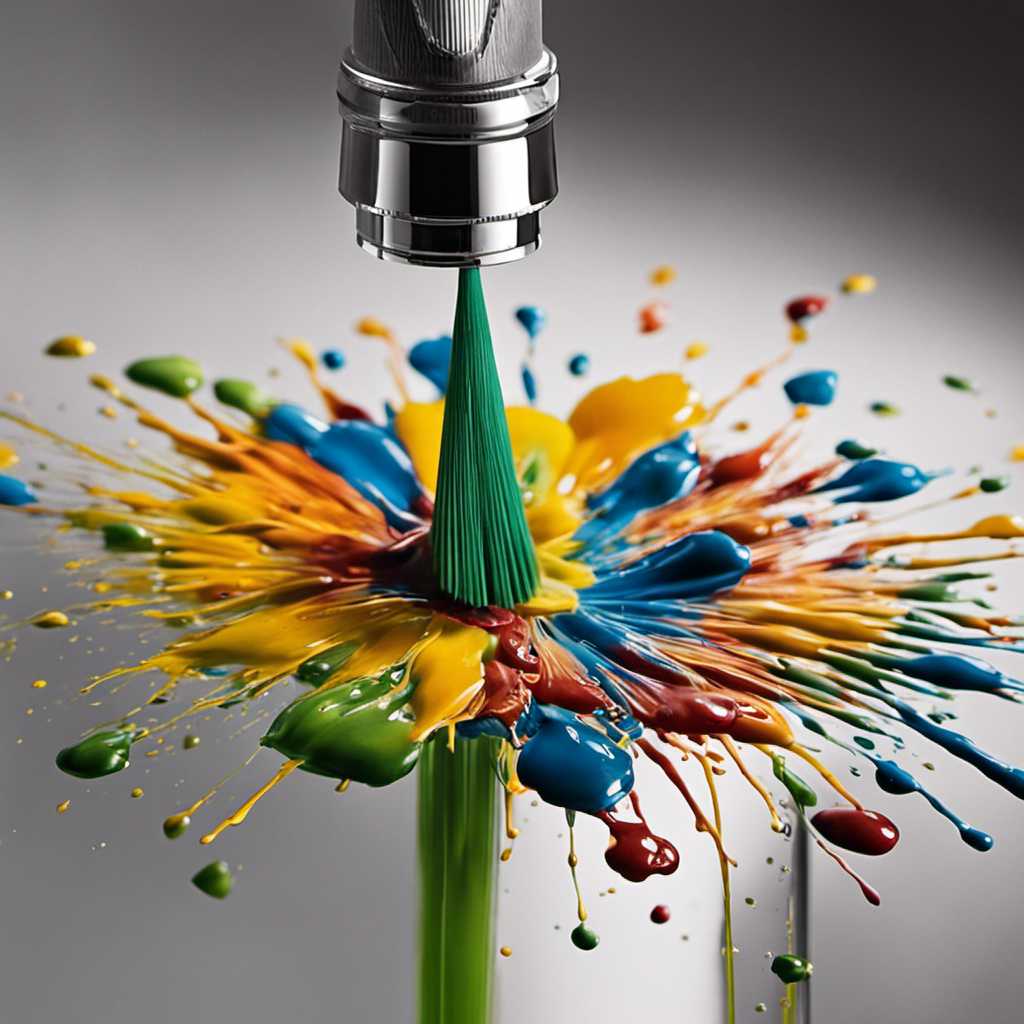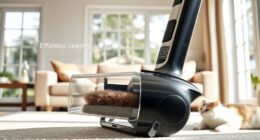To get even coverage when spraying popcorn ceilings or textured surfaces, start with a clean, dry, dust-free surface, patch any cracks, and apply primer if needed. Use the right spray equipment and test it before beginning. Keep a steady hand, hold the spray gun 18-24 inches from the ceiling, and move smoothly in overlapping motions. Paying attention to technique and equipment adjustments helps achieve a professional finish—continue exploring for more tips to perfect your application.
Key Takeaways
- Maintain a consistent spray distance of 18-24 inches for even texture application.
- Keep the spray gun moving smoothly in overlapping passes to prevent uneven patches.
- Adjust spray tip size and pressure settings for controlled, uniform coverage.
- Prepare the surface thoroughly, patch cracks, and use primer if needed for better adhesion.
- Test spray on scrap or hidden areas to fine-tune technique before the main application.
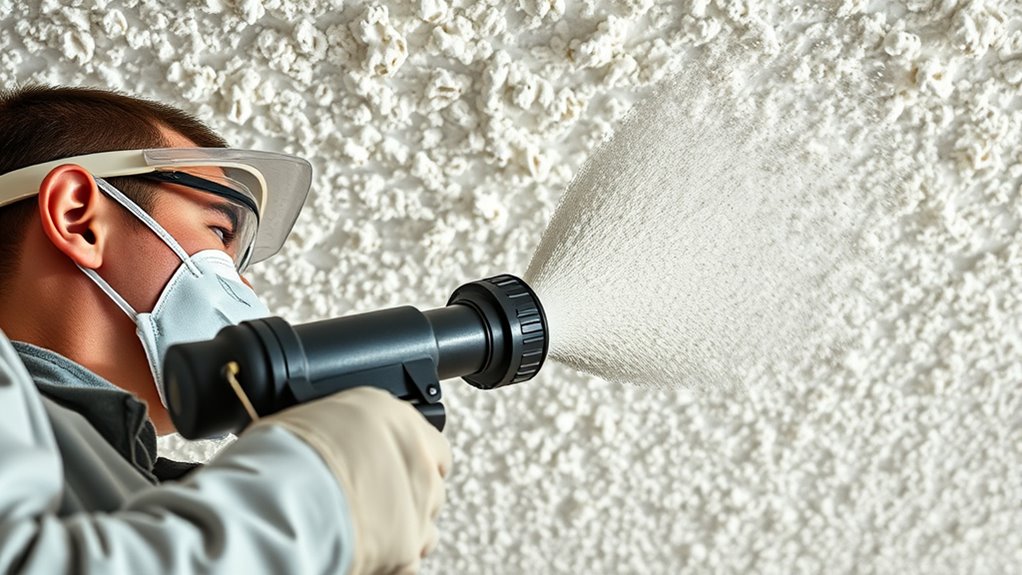
Spraying popcorn ceilings is a popular method for adding texture and hiding imperfections on your ceiling surface. If you’re tackling this project yourself, understanding how to achieve even coverage is essential. One of the key factors is guaranteeing proper texture adhesion. When the texture doesn’t stick well, it can lead to uneven patches or peeling over time. To prevent this, start with a clean, dry surface free of dust and grease. Lightly patch any cracks or holes beforehand, and consider applying a primer if the ceiling has been previously painted or if you’re working on a surface with low porosity. A good primer can improve texture adhesion, making sure the spray material bonds evenly across the entire ceiling.
Next, focus on selecting and setting up your spray equipment correctly. There are various spray tools available, from handheld airless sprayers to larger professional-grade machines. For a typical popcorn ceiling texture, a hopper gun or a spray hopper connected to an air compressor often works best. Make sure your spray equipment is clean and in good working order before starting. Adjust the spray tip to the appropriate size—usually around 1/8 to 1/4 inch—so you can control the spray pattern and get a consistent application. Proper equipment setup isn’t just about the nozzle; it’s also about maintaining the right pressure. Too much pressure can cause overspray and uneven texture, while too little can result in a thin, patchy finish. Test your spray pattern on a scrap piece or a hidden section of the ceiling to fine-tune the settings before proceeding.
Once you’re ready to spray, keep a consistent distance from the ceiling—typically around 18 to 24 inches—and use smooth, sweeping motions. Don’t stay in one spot too long, as this can cause buildup and uneven texture. Keep the spray equipment moving steadily to distribute the material evenly. Moving too fast may leave gaps, while moving too slow can create thick blobs. Maintain a consistent speed and overlap each pass slightly to ensure even coverage. If you notice areas that appear sparse or uneven, don’t hesitate to go back over them gently after the initial coat has dried. Proper technique, combined with attention to spray equipment adjustments and ensuring good texture adhesion, will help you achieve a professional-looking, uniform popcorn ceiling.
Frequently Asked Questions
How Do I Remove Old Popcorn Ceiling Texture Safely?
To remove an old popcorn ceiling safely, start by checking for asbestos beforehand. If present, hire professionals for removal. Otherwise, prepare surfaces by covering floors and furniture. Wear protective gear like masks and goggles, then mist the ceiling with water to loosen texture. Use a scraper gently to remove it, ensuring even coverage and safety. Proper preparation and precautions help guarantee a smooth, safe removal process.
What Type of Spray Equipment Is Best for Textured Surfaces?
Choosing the right spray equipment is like picking the perfect brush for a masterpiece; it sets the tone for a smooth finish. You want equipment that offers adjustable pressure and a wide spray pattern, enabling precise control. Focus on proper equipment selection and technique to make certain of even coverage. Use a hopper gun or airless sprayer for textured surfaces, which help evenly distribute material and eliminate uneven patches, creating a professional-looking result.
Can I Spray Popcorn Ceiling Over Existing Paint?
You can spray a popcorn ceiling over existing paint, but you should prepare properly. Use DIY techniques like cleaning the surface and repairing any damage beforehand. For the best results, consider professional tools like a high-quality spray gun, which helps guarantee even coverage. Keep the spray at the right distance and work in sections to avoid drips and uneven texture. Proper preparation and equipment are key for a smooth, professional-looking finish.
How Long Does It Take for the Texture to Dry?
The drying time for popcorn ceiling texture typically takes about 24 to 48 hours, but it can vary based on environmental factors. You should guarantee good ventilation and lower humidity levels to speed up drying. Keep the area well-ventilated and avoid touching or disturbing the surface during this period. Remember, patience is key; rushing the process might cause uneven texture or other issues.
What Safety Precautions Should I Follow During Spraying?
Oh, safety first—because who doesn’t love breathing in a delightful cloud of spray? You should wear protective gear like masks and goggles to keep dust and fumes out. Make sure your space is well-ventilated, opening windows and using fans. Keep a safe distance from the spray zone, and avoid skin contact. Remember, a little caution now saves you from a big headache later!
Conclusion
To achieve a smooth, even popcorn ceiling or textured surface, proper spraying techniques are essential. Remember, using the right equipment and maintaining consistent distance helps prevent uneven coverage. Did you know that improper spraying can result in up to 30% material waste? By following these methods, you’ll minimize waste and guarantee a professional-looking finish. With patience and practice, you’ll master the art of spraying textured surfaces, making your project both efficient and satisfying.
Franz came aboard the Paint Sprayer Zone team with a background in both journalism and home renovation. His articulate writing style, combined with a passion for DIY projects, makes him an invaluable asset. Franz has a knack for breaking down technical jargon into easy-to-understand content, ensuring that even the most novice of readers can grasp the complexities of paint sprayers.
